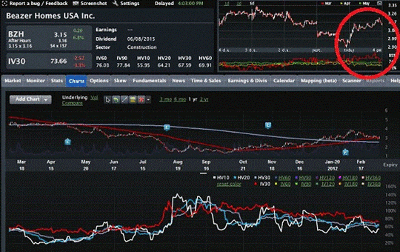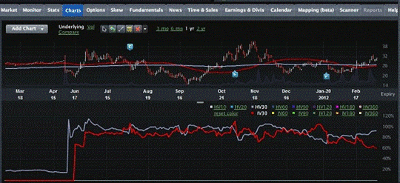When defining the time frame and expected price movement for a trade, option traders actually make a distinction between an option trade and an option position, explains Mark Sebastian.
I will lay all talk of the Greek Tragedy aside for the most part today. We'll either run down a bit on Friday or gain a nice little boost, but there seems a bit of a buildup in the air. We have talked about the bid-up juice in the volatility products enough (although a bit of a decline today) over the last couple of weeks, and it made for some nice trades.
What I would like to discuss is the time lines on these trades. What makes a trade, and what makes a position?
I was recently watching the price action in some of the homebuilders. I think it was Hovnanian Enterprises (HOV) that reported a bit better than expected, and there was short burst of activity for the group. At this point, Beazer Homes (BZH) was up the most. I know the homebuilders are just scrapping off the bottom, so a trade that looked interesting was selling the BZH APR $3.00 straddles for 70 cents.
I was hoping for about 74% or so volatility on it. BZH is pretty range bound, and I thought that level was not too bad, as long as it was short-term enough. To me, that is a trade. It's relatively short term in nature and I'm looking for a very quick strike of maybe .20 or so, if I can get my entry level. As far as current market conditions, BZH has not traded at $2.30 for months, so the real risk I think is to the upside.
I am not thinking this short straddle is a long-term play. Most likely, Thursday was the only day for the April cycle where the pricing got remotely interesting.
On the other hand, for a position trade, my time horizon is a bit different. On the flip side, I also am looking at Fusion-io (FIO). I actually heard it on the Option Insider Radio last week and looked up the name. The volatility numbers looked very interesting. I don't really care about the fundamental story, but the company sells stuff to Facebook and Apple (AAPL). That is probably enough of a story for most.
The 30-day historical volatility (HV) in FIO has not spent one moment since it's IPO below 70% on a 30-day basis. I see June implied volatility (IV) trading for 60%. When I look to take a position, I am thinking this is a long-term trade in order to make it work out.
April might work, but the June cycle will catch the earnings for sure, which puts a bit of a floor under the options. Here, I am thinking a month or two holding period, if necessary.
Most traders new to options would be well served if they thought of the trading time line prior to entry. That way a plan can take shape, and with the various bailouts and adjustments set well ahead of time, some of the hard thinking on exit strategy is pre-determined.
As we move through this week and big possible news next week, are your positions ready for it?
See also: Big Events Option Traders Can Bank on
By Mark Sebastian of OptionPit.com























